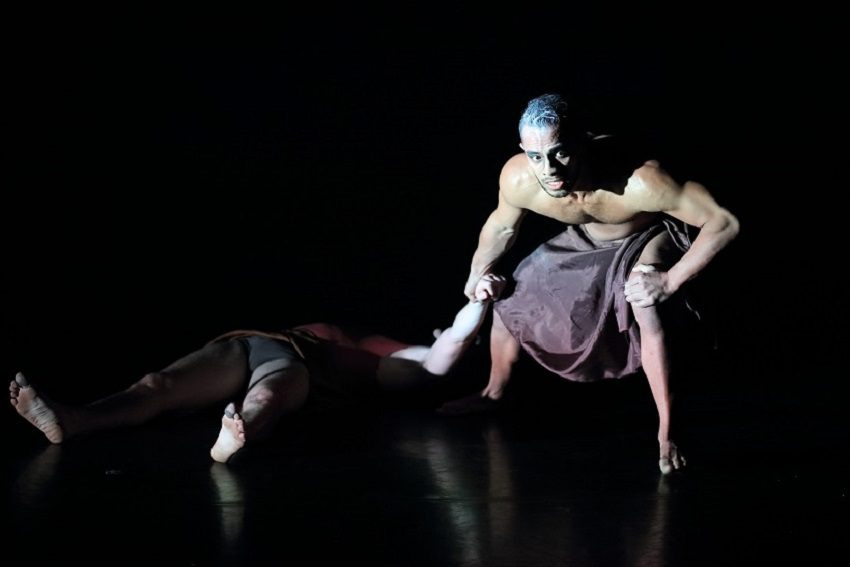Australian Dance Theatre: A Long History of Experimentation

Adelaide has an illustrious history of creating new, experimental dance, from Australian Dance Theatre’s founding in 1965, to its prolific output of today.
When Elizabeth Dalman established Australian Dance Theatre (ADT) in 1965, she brought methods, techniques and ideas from Europe and later America, and encouraged creativity in her student/performers. In 1967, she began holding monthly workshop performances in the group’s Gay’s Arcade studio.
Jonathan Taylor, ADT artistic director from 1976 to ‘86, developed the idea into fewer but more fully developed performances, and a program in the Space Theatre in November 1977 included Cheryl Stock’s En Passant, probably the first Australian interactive dance work, in which sound was produced by the dancers’ feet as they moved on pads on the floor connected electronically to amplifiers.
By 1980, other strong choreographic talent was emerging, particularly in Margaret Wilson, who combined humour with acute observation of human nature.
 A scene from ADT’s WOOLF! by Matte Roffe
A scene from ADT’s WOOLF! by Matte Roffe
In 1982, the greatest originality came from John Nobbs’s take on Shakespeare’s Othello, which he set to a slowed-down version of Laurie Anderson’s O Superman. It was surprisingly successful, and evidenced Nobbs’s interest in Shakespeare which led to his becoming the only Australian invited to perform with Tadashi Suzuki’s company in Japan and internationally, including The Chronicle of Macbeth at the 1992 Adelaide Festival.
Nobbs now codirects OzFrank Productions in Brisbane. Stock, Wilson and Nobbs are three alumni of those early ADT workshops who have gone on to notable careers. Dancer, choreographer, teacher, administrator, Stock has held among other posts: Head of Dance at Queensland University of Technology, Chair of the Australia Council’s Dance Board, and, since 2009, Secretary General of the World Dance Alliance.
She was made a Member of the Order of Australia (AM) in 2014 and was recently appointed Head of Cultural Leadership at the National Institute of Dramatic Art (NIDA).
 Caught in Past Tense is a short 10 minute piece from Katrina Lazaroff
Caught in Past Tense is a short 10 minute piece from Katrina Lazaroff
Margaret Wilson had danced with Nederlands Dans Theatre before joining ADT, where she developed her choreographic skills, and won awards which took her to America and Canada.
Since 1990, she has taught contemporary dance at the Australian Ballet School, and choreographed for the Australian Ballet’s season of new pieces, Bodytorque, in Sydney. ADT’s next director, Leigh Warren (1986 to ‘92), a skilled and inventive choreographer himself, continued the tradition, under a variety of names – Acceleration (1988), Dance Access (1989) and The Dancers Choreograph (1991) among them. Susan Peacock, now lecturing at WAAPA, and Chrissie Parrott, one of Australia’s most prolific choreographers, both produced works during his tenure.
When Meryl Tankard became ADT director in 1992, the repertoire was confined to her work except for Miniatures, two programs of new pieces by dancers.
Significantly, they included Shaun Parker, now with his own company, Michelle Ryan, artistic director of Restless Dance Theatre, Ingrid Weisfelt and Vincent Crowley, of Torque Show, and Gavin Webber, co-founder of The Farm.
 Erin Fowler’s Epoch examined the cyclical nature of history for ADT’s Ignition series
Erin Fowler’s Epoch examined the cyclical nature of history for ADT’s Ignition series
Since taking over in 2000, Garry Stewart has had notable success in nurturing his dancers’ creativity. The first of the ongoing series imaginatively titled Ignition included works by Peter Sheedy, Anthony Hamilton and Tanja Liedtke, all of whom went on to win choreographic awards.
Stewart hit on the idea of giving the dancers a theme – in November 2003 it was The Nutrcacker. And two who have since become seasoned choreographers, Larisssa McGowan and Lina Limosani, were among the contributors. McGowan’s steady upward path, which included making 10 pieces for Ignition over the years, has led through several awards for dance and choreography to becoming ADT’s assistant choreographer 2008 to ‘11, and freelancing since.
Limosani has built an international reputation, and was handed the Dame Peggy van Praagh Fellowship at last year’s Australian Dance Awards. Her latest work, One’s Wicked Way, was a hit at last month’s Ignition season.
 Another Ignition piece, One’s Wicked Ways by Lina Limosani
Another Ignition piece, One’s Wicked Ways by Lina Limosani
ADT workshops by whatever name have been a spawning ground not only for choreographers, but for dancer-choreographers such as Michael Thwaites, who was in Twyla Tharp’s company in New York and Pina Bausch’s in Wuppertal and now lectures at WAAPA, and Mark Baldwin, artistic director of London’s Ballet Rambert since 2002 and recipient of OBE last year.
Van Praagh and Peter Brinson open their book The Choreographic Art with the words: “Dancing is a language whose words are movements of the body. Choreography is the art of assembling movements creatively so that they have meaning, style and form.” May the ADT tradition of encouraging the choreographic art long continue to flourish.
Photos: Tony Lewis